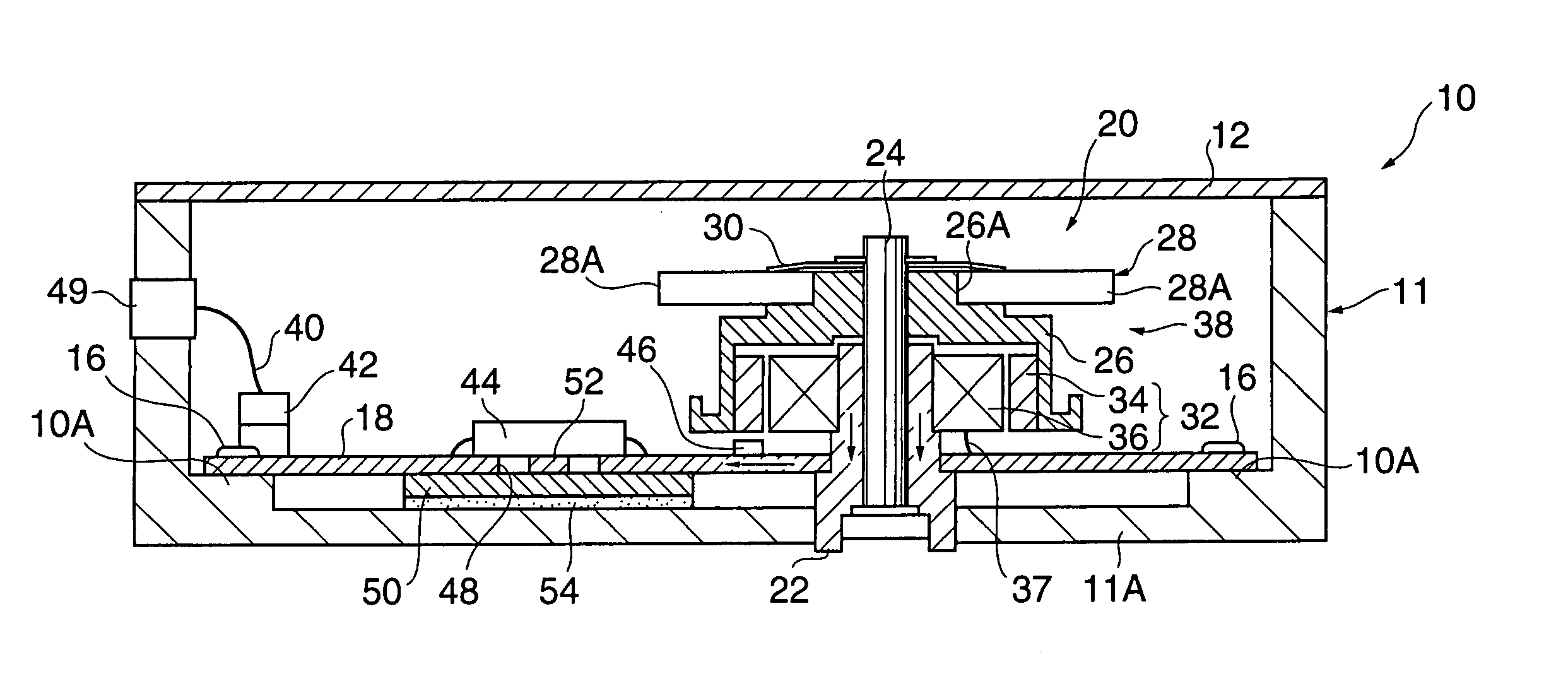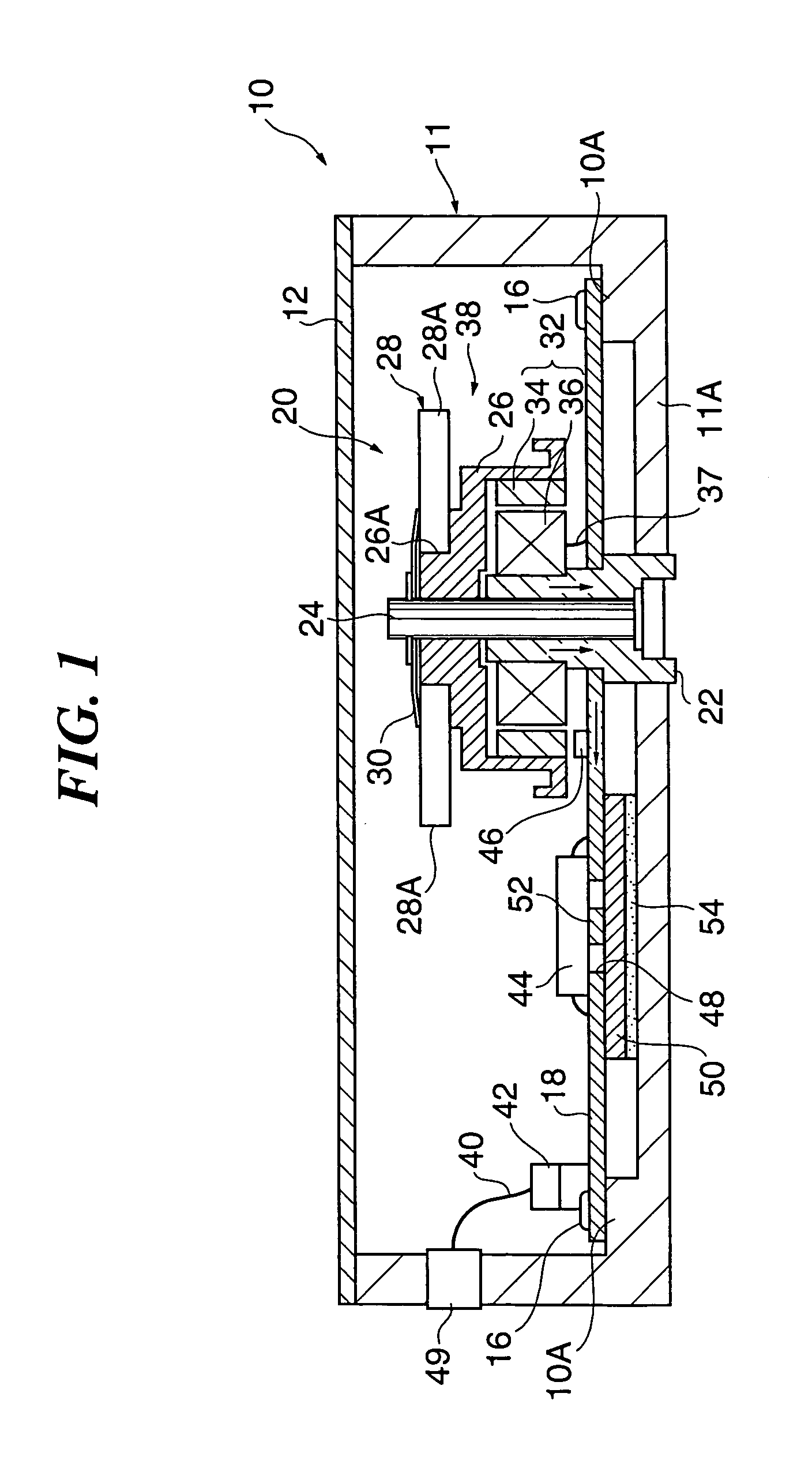Optical deflector and optical scanner having the optical deflector
- Summary
- Abstract
- Description
- Claims
- Application Information
AI Technical Summary
Benefits of technology
Problems solved by technology
Method used
Image
Examples
first embodiment
[0059]Hereinafter, an optical scanner of the present invention is described.
[0060]FIG. 1 is a sectional view of an optical scanner 10, which is formed in box shape and substantially sealed with its opening covered with a cover 12. Seats 10A are projectingly mounted in the corners of a bottom wall 11a of a housing 11 of the optical scanner 10, and a metallic printed board 18 is secured by mounting screws 16.
[0061]A substantially cylindrical bearing 22 with a bottom constituting an optical deflector 20 penetrates through the printed board 18, and a rotation shaft 24 is fitted in the bearing 22 and rotatably supported.
[0062]A substantially tube-like rotation sleeve 26 is secured in an upper portion of the rotation shaft 24 and is rotatable integrally with the rotation shaft 24. In an upper portion of the rotation sleeve 26 is provided a small-diameter portion 26A, around which a polygon mirror 28 configured with plural mirrors 28A is fitted and secured to the rotation sleeve 26 by a ri...
second embodiment
[0091]The following describes the operation of the optical scanner of the present invention.
[0092]As shown in FIG. 5, by making the housing 62 itself of the optical scanner 60 a radiating member, heat generated by the integrated circuit 44 is radiated to the outside through the silicon rubber 66 and the seat 64.
[0093]Heat within the housing 62 generated by the motor 32 can be radiated through the printed board 18, the silicon rubber 66, and the seat 64. Therefore, without using a special radiating member, a rise in the temperature in the integrated circuit 44 and the housing 62 can be reduced.
[0094]Furthermore, by providing the clearance 69 between the mount 68 provided in the laser printer and the back of the optical scanner 60, and providing the mount 68 with a cooling unit such as the fan 70, air outside the housing 69 is allowed to flow to the clearance 69 and the bottom wall 62A of the housing 62 is cooled, and heat radiated by the housing 62 is allowed to flow in a direction t...
third embodiment
[0104]The following describes the operation of the optical scanner of the present invention.
[0105]As shown in FIG. 6, the mounting part 76 is projectingly mounted in the bottom wall 74A of the housing 74 and provided with the through hole 78 corresponding to the through hole 48. By inserting the ribs 80B of the radiating member 80 in the through hole 78, the ribs 80B are exposed to outside the housing 74.
[0106]With this construction, heat generated from the integrated circuit 44 and the motor 32 can be radiated to outside the housing 74 through the radiating member 80. Therefore, a rise in the temperature in the integrated circuit 44 and the housing 74 can be reduced.
[0107]With the printed board 18 secured to the seats 72A, the height of the radiating member 80 disposed on the elastic member 82 is higher than a clearance between the printed board 18 and the upper face of the mounting part 76, and the elastic member 84 is formed so as to be thicker than the printed board 18.
[0108]Wit...
PUM
 Login to view more
Login to view more Abstract
Description
Claims
Application Information
 Login to view more
Login to view more - R&D Engineer
- R&D Manager
- IP Professional
- Industry Leading Data Capabilities
- Powerful AI technology
- Patent DNA Extraction
Browse by: Latest US Patents, China's latest patents, Technical Efficacy Thesaurus, Application Domain, Technology Topic.
© 2024 PatSnap. All rights reserved.Legal|Privacy policy|Modern Slavery Act Transparency Statement|Sitemap



